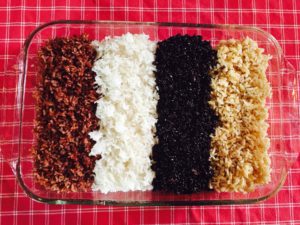Beans and Rice Multi Colored Because Diversity Is Delicious
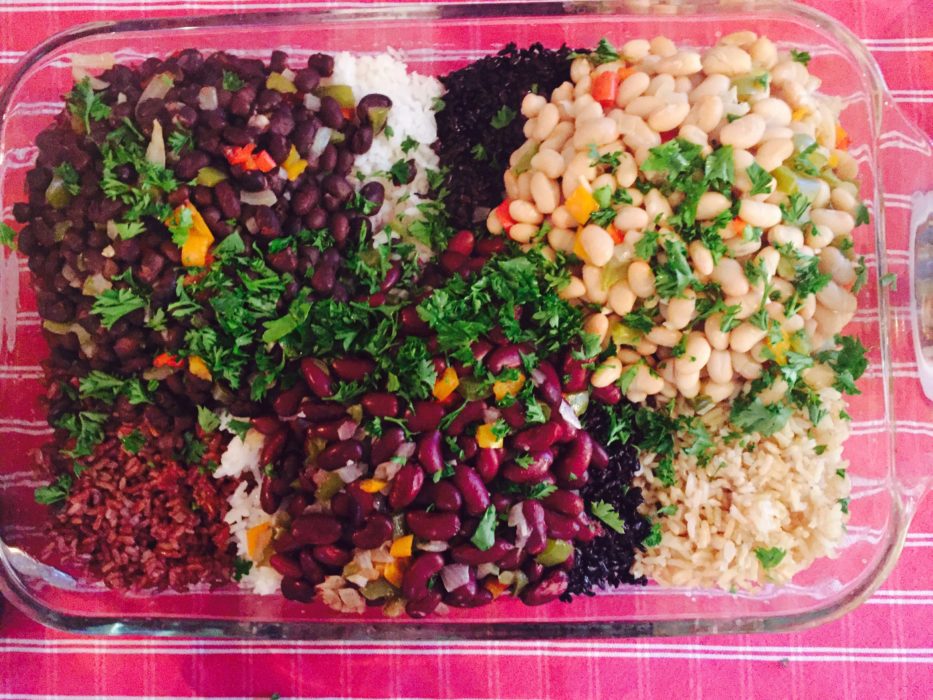
(to accompany this essay also on Huffington Post): Sometimes a dish of beans and rice is just the thing, the just thing. I live in Charlottesville, plenty famous enough, thank you very much, without the white supremacist rally mid-August that catapulted our town into national news. It was that event and its aftermath that inspired this dish.

This meal plays a central role a brief piece that I composed imagining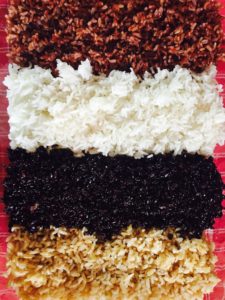 a different kind of August 12 and a radically nonviolent way (but no less demanding of fortitude and courage) to resist such hate and hateful gatherings in the future. Here’s a link to that piece on The Huffington Post.
a different kind of August 12 and a radically nonviolent way (but no less demanding of fortitude and courage) to resist such hate and hateful gatherings in the future. Here’s a link to that piece on The Huffington Post.
The food is simple of course, beans and rice, and inexpensive. It’s healthy, too. So that’s a bonus.
But it’s also a rather literal expression of the deliciousness of diversity and of simply getting along. It’s white rice with black beans, red rice with white beans, brown rice with red beans, yellow rice with black beans,… A little tongue-in-cheek, slap in the face (er, figuratively) to those who don’t believe that “only laundry should be sorted by color” as some memorable anti-racist protest posters read.
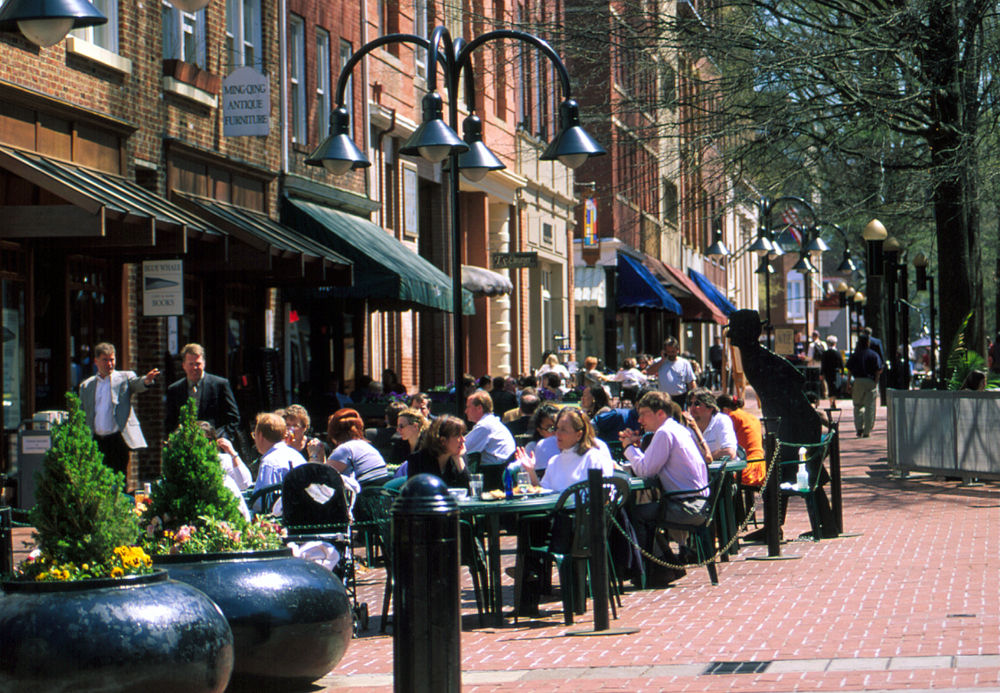
To the food!
The Rice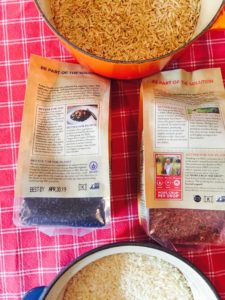
While this whole endeavor is really quite easy, each color of rice does need its own cooking pot. We’ll get to the beans in a minute. For the sake of energy efficiency, electric rice cookers are great, especially if you live in a hot climate or otherwise might need to air condition. Just know that since your goal is to get batches of different rice cooked, if you’re going the rice cooker route and unless you’ve got four or five rice cookers, you’ll want to get started well ahead of meal-time. (The rice can hang out at room temperature for several hours without worrying about food safety.)
For those of us without even a single rice cooker (maybe one day), I recommend the oven. Yup. For this bonanza of rices, I actually bake them. That way, you can do the whole kit-n-kaboodle at once (or twice, depending on your oven size),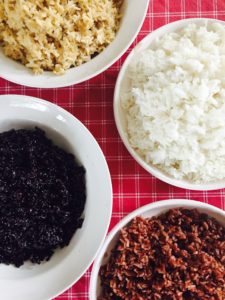 saving time and energy, too. The only hitch: you need as many cover-able, oven-safe pots as colors of rice you’d like to have.
saving time and energy, too. The only hitch: you need as many cover-able, oven-safe pots as colors of rice you’d like to have.
From there, just cook pretty much according to the directions on the rice bag: Pour the requisite amount of boiling water (I use an electric, counter-top kettle) over the corresponding amount of rice (1 ¾ C. water over 1 C. brown rice, e.g.), add a splash of oil, cover, and bake at 350 for the requisite amount of time. When it’s done (check to see if the water’s been absorbed all the way to the bottom of the pot), uncover and fluff with a fork. This helps prevent the lower layers from getting gummy. Truth: it’ll still be good if you don’t fully fluff.
The Sofrito
Meanwhile, prepare your sofrito (or soffrito) – a fancy word for the sautéed chopped v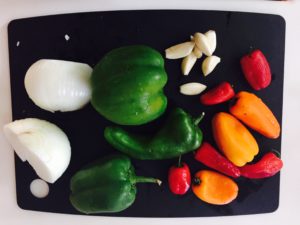 egetables that provide a flavor base (and visual interest) for the beans. I made a lot. You don’t have to. The amount of sofrito is wildly forgiving. So, too, the veg combination. See what you’ve got in the fridge, the garden, or your latest farmer’s market haul.
egetables that provide a flavor base (and visual interest) for the beans. I made a lot. You don’t have to. The amount of sofrito is wildly forgiving. So, too, the veg combination. See what you’ve got in the fridge, the garden, or your latest farmer’s market haul.
The sofrito should include onions. It can include garlic, sweet peppers of any or every color, celery (but err on the less-is-more side), even diced carrots. This is not the time for tomatoes, much as I love them, or other fall-aparts like eggplant or zucchini. We’re going for simple, savory flavor. Sofrito is a supporting actor. To that end, no piece of veg should be as big as the headliner – your beans. So, peel and chop ’em up pretty small – diced, if you’re so inclined.
If your oven is big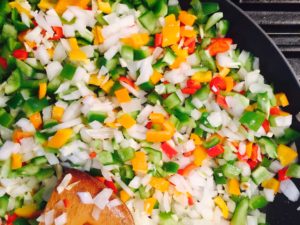 enough, you can actually cook the sofrito on a sheet pan (make sure you’ve greased it with oil, and give it a stir a couple times through) at the same time as your rice. Otherwise, do it on the stove over medium to medium high heat. (You’ll have extra sofrito. It lasts in the fridge for a 7-10 days and is great with eggs.)
enough, you can actually cook the sofrito on a sheet pan (make sure you’ve greased it with oil, and give it a stir a couple times through) at the same time as your rice. Otherwise, do it on the stove over medium to medium high heat. (You’ll have extra sofrito. It lasts in the fridge for a 7-10 days and is great with eggs.)
It’s okay if the rice finishes before you’re done with other things. It can sit cooling and even remain at room temperature for several hours before compromising quality or food safety.
The Beans
When the sofrito is done, you’re ready to assemble your beans. I took the super easy route of using canned beans. You can, too. Permission here granted. If you’re cooking your own beans, good on you. Just please make a lot at a time. (It takes as much energy to cook a tablespoon as a quart.) They freeze great, with enough cooking water to cover, in one of those gazillion yogurt/ cottage chees/ take-out/ canning jars (!yay!) that we all have lying around. I do think that the color of black beans is better when you cook them yourself than when they drop out of a can. But hey, canned beans are great, and a pretty good kitchen has a few in the cupboard somewhere.
I assemble the whole thing in a 9×13 pan (well oiled), with the rice in rows and the beans
overlapping the rice boundaries in piles on top. That way, I can heat the whole thing up at once, too. But I’ll bet it would look great in wedges on a big circular platter, or of course if each thing is already warm, assembled in individual bowls.
I sprinkled chopped parsley on top (and forgot to take a picture), which adds a nice touch. You could do cilantro. I served it with bottles of hot sauce on the table, a bowl of crumbled queso fresco (use any mild cheese – grated or crumbled) to pass around, and a side of sliced fresh tomatoes (because they were in season) dressed only with flaky sea salt.
Whatever you do, don’t worry. It’s going to be great.
Oh, and this is gluten free, sugar free, vegetarian, and a complete protein. Plus, if a person elects to forgo the cheese optional topping, this is also lactose-free and straight-up vegan. What’s not to love? Love the love.
Multi-Colored Beans and Rice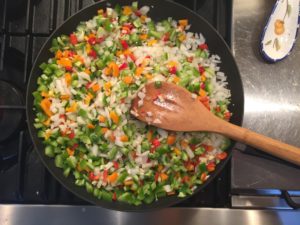
The following recipe serves 6-8.
Ingredients
2 C. each, cooked rice of four different colors
1 1/2 C. each, cooked beans of three different colors (canned are fine, see above)
3 T. vegetable oil plus more to grease the 9×13 inch baking pan
1 medium-sized onion, chopped
2 garlic cloves (optional), diced
1 C. green pepper (or 1 stalk celery), chopped
½ C. red and or yellow peppers (or 1 large carrot, peeled), chopped
salt to taste (see below)
½ C. parsley (curly or flat-leaf) and/or cilantro, chopped
8-12 oz. queso fresco or other mild cheese, crumbled or grated
bottles of hot sauce for the table
Preparation
- Generously oil a 9×13 inch oven-proof baking pan.
- Carefully arrange the rice in rows of contrasting color.
- Rinse the beans and empty into separate bowls. Stir ¼ C. sofrito into each bowl. Add salt to taste.
- Carefully pile one color of beans to overlap two colors of rice. Continue with the other beans.
- Heat in the oven (preheated or not, no worries), set to 350, for 10-15 minutes, until the beans and rice are warm. (They don’t need to be piping hot.)
- While that heats, crumble your cheese into a bowl.
- When the rice and beans are warm, remove them from the oven.
- Sprinkle parsley and/or cilantro over the top.
- Serve with optional cheese and hot sauces.
Kumbaya, my friends. Kumbaya.

